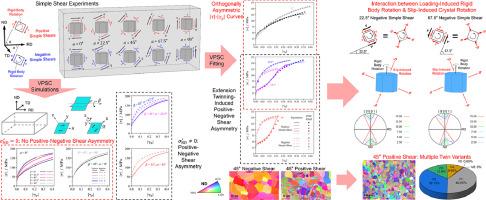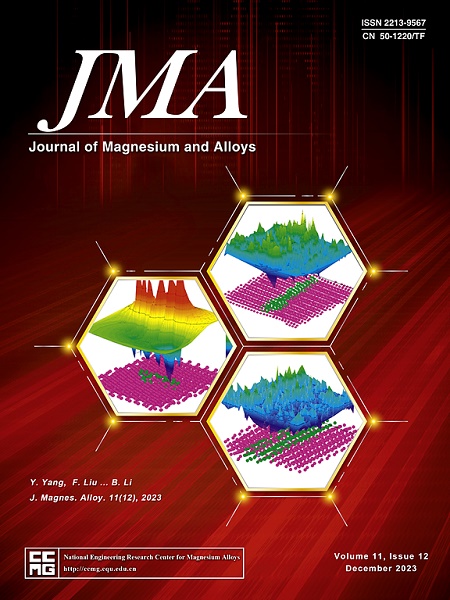Positive-negative shear asymmetry and anisotropy of a textured rolled plate of AZ31B Mg alloy under simple shear
IF 15.8
1区 材料科学
Q1 METALLURGY & METALLURGICAL ENGINEERING
引用次数: 0
Abstract
Mg alloy often undergoes shear deformation during industrial processing. While its anisotropy and tension-compression asymmetry have been thoroughly studied under uniaxial loading, the understanding for shear loading is still lacking. This study employed a rolled AZ31B plate with typical basal texture to investigate the shear behaviors. Positive and negative simple shear experiments were performed at different angles in the transverse plane, whereby the visco-plastic self-consistent model was calibrated to reveal the deformation mechanisms and predict the mechanical responses at various orientations. Positive-negative shear asymmetry is present because extension twinning preferentially operates in one shear direction but is suppressed in the opposite direction. Simple shear induces multiple twin variants, thus impedes twin growth and slows the consumption of matrix, as compared to in-plane compression. For slip dominated simple shear, the interaction between loading-induced rigid body rotation and slip-induced crystal rotation produces distinct hardening behaviors, namely orthogonally asymmetric mechanical responses at complementary loading angles, which is largely absent in uniaxial loading. Finally, simulation results verify that positive-negative shear asymmetry appears only when the deviatoric normal stress on the sheet plane is non-zero. Positive-negative shear asymmetry persists except for the conditions of shear plane parallel to sheet plane, or shear direction parallel or perpendicular to rolling direction.

单纯剪切作用下AZ31B镁合金织构轧制板的正-负剪切不对称性和各向异性
镁合金在工业加工过程中经常发生剪切变形。虽然在单轴加载下对其各向异性和拉压不对称性的研究较为深入,但对剪切加载的认识还比较欠缺。本研究采用具有典型基底织构的AZ31B轧制板进行剪切行为研究。在横向不同角度进行正、负单剪试验,标定粘塑性自洽模型,揭示变形机理,预测不同方向的力学响应。由于伸展孪晶优先在一个剪切方向上发生,而在相反方向上受到抑制,因此存在正-负剪切不对称。与面内压缩相比,单剪切诱导多个孪晶变异,从而阻碍孪晶生长,减缓基体的消耗。对于滑移主导的单剪切,加载诱导的刚体旋转和滑移诱导的晶体旋转的相互作用产生了明显的硬化行为,即互补加载角下的正交不对称力学响应,而单轴加载时基本没有。最后,仿真结果验证了板料平面上的偏正应力不为零时才会出现正负剪切不对称。除剪切平面平行于板料平面或剪切方向平行于或垂直于轧制方向外,正负剪切不对称仍然存在。
本文章由计算机程序翻译,如有差异,请以英文原文为准。
求助全文
约1分钟内获得全文
求助全文
来源期刊

Journal of Magnesium and Alloys
Engineering-Mechanics of Materials
CiteScore
20.20
自引率
14.80%
发文量
52
审稿时长
59 days
期刊介绍:
The Journal of Magnesium and Alloys serves as a global platform for both theoretical and experimental studies in magnesium science and engineering. It welcomes submissions investigating various scientific and engineering factors impacting the metallurgy, processing, microstructure, properties, and applications of magnesium and alloys. The journal covers all aspects of magnesium and alloy research, including raw materials, alloy casting, extrusion and deformation, corrosion and surface treatment, joining and machining, simulation and modeling, microstructure evolution and mechanical properties, new alloy development, magnesium-based composites, bio-materials and energy materials, applications, and recycling.
 求助内容:
求助内容: 应助结果提醒方式:
应助结果提醒方式:


